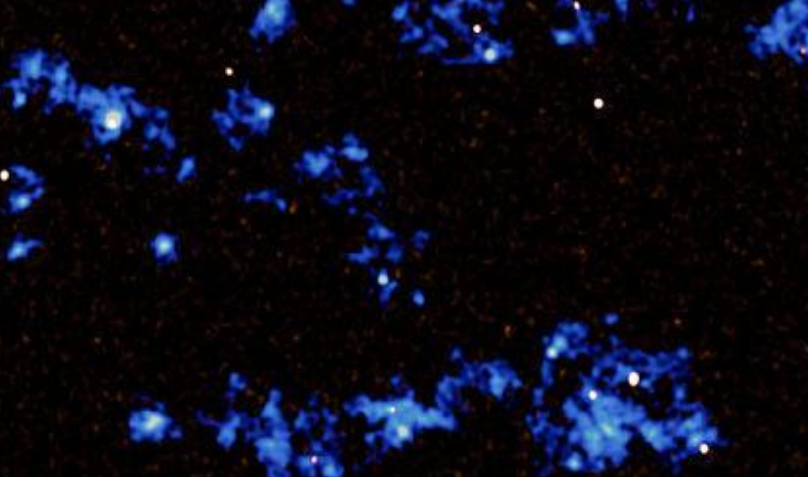Gas Filaments That Feed Galaxies Spotted for First Time

Image Courtesy: Science
Where do the galaxies of the universe lie? According to the prevailing cosmology theory, every galaxy is embedded into a vast network of filaments and sheets made up of hydrogen gas. This proposition has so far been limited to only theoretical predictions. No direct evidence in support of this had been possible as viewing the gas filaments is an extremely difficult task. These filaments are diffused and are also feathery. But, now an international team of scientists has spotted two such filament strands in an ancient cluster of galaxy.
This first time observation of the cosmic filaments also strengthens the dark matter theory of galaxy formation. This theory says that at the advent of Big Bang, hydrogen gas that was formed eventually collapsed into sheets and then into filaments. These gas sheets and filaments are expanded across space forming a cosmic web. In the places where the filaments cross or are clustered together, galaxies are formed and the filaments continue to fuel the growth of galaxies by feeding them a steady stream of gas. The standard theory says that with the evolution of the universe, the dark matters combine to form clusters and strands in a vast cosmic web. The hydrogen gas collected in the clusters formed the stars inside the galaxies. The hydrogen molecules also spread along the filaments to feed the growing galaxies.
The team belonging to Japanese research agency RIKEN and University of Tokyo were able to trace two such enormous hydrogen filaments for the first time. These filaments appeared in a cluster of galaxies that appeared just 2 billion years after the Big Bang, as reported in Science. The observations revealed that the ancient cluster of galaxies that are about 12 billion light years away in the constellation of Aquarius are linked together by a network of filaments.
In their observations, the scientists captured the light radiated by the galaxies in the cluster at a particular wavelength. Hydrogen gas was heated by the galaxies and the irradiation that emanated was captured by them. For this purpose, the scientists used the European Southern Observatory’s Very Large Telescope on Cerro Paranal in northern Chile. They were also able to detect individual filaments of intergalactic gas that spanned young galaxies in a newly emerging cluster.
“It is very exciting to clearly see for the first time multiple and extended filaments in the early universe. We finally have a way to map these structures directly and to understand in detail their role in regulating the formation of supermassive black holes and galaxies,” said Professor Michele Fumagalli, an astrophysicist at Durham University and also a co-author of the study.
Hideki Umehata, the pioneer of the study of the RIKEN Cluster for Pioneering Research and University of Tokyo said, “This suggests very strongly that gas falling along the filaments under the force of gravity triggers the formation of star bursting galaxies and supermassive black holes, giving the universe the structure that we see today.”
Earlier, astronomers could observe how the gravity of the cosmic web’s filaments results in a distortion of the images of more distant galaxies and make them align slightly. Also, astronomers could reveal huge intergalactic clouds of hydrogen. They did it by measuring the light absorbed by this cloud from very distant galaxies called the quasars. But, till now it was not possible to see the streams of gas themselves and their tie up with galaxies they feed.
Get the latest reports & analysis with people's perspective on Protests, movements & deep analytical videos, discussions of the current affairs in your Telegram app. Subscribe to NewsClick's Telegram channel & get Real-Time updates on stories, as they get published on our website.














